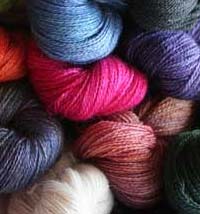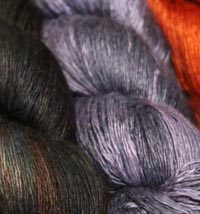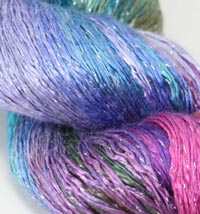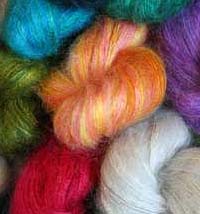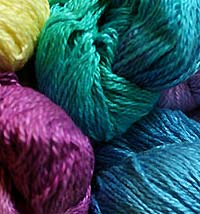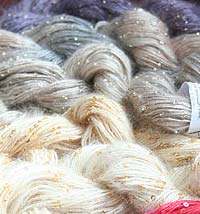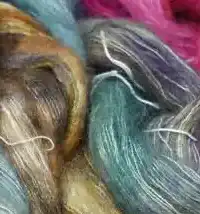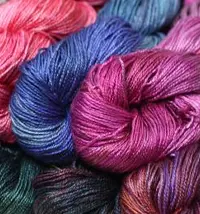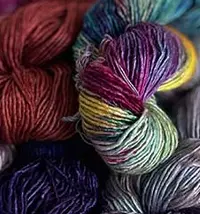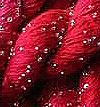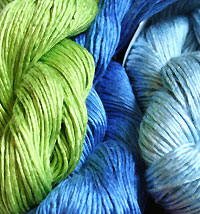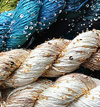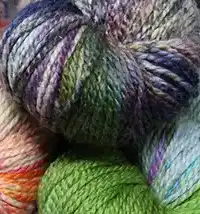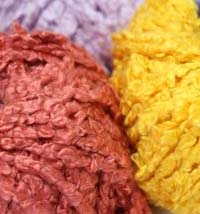SILK YARNS
LACE WEIGHT SILK YARNS
DK/SPORT/FINGERING WEIGHT SILK YARNS
BULKY WEIGHT SILK YARNS
Knitting With Silk Yarn: A Luxurious Experience
Have you ever heard any one say "You HAVE try knitting with silk yarn at least once in your life?" It happened to us, and it's one of the reasons we stock so many luxury silk yarns. Knitting with silk simply changed everything we thought we knew about yarn. Seriously, it's an experience like no other. The sheen, the drape, the way it feels running through your fingers. Pure luxury. And the Finished Objects?? Next level beautiful. Sure, silk can be spendy but it's so worth it. Even just a silk blend transforms a project into something really special. Don't let the delicate reputation scare you off either. With the right care silk is plenty durable, and the colors are to die for. So do yourself a favor and treat yourself to some silk yarn. Your knitting will never be the same, in the best possible way.
Tips and Tricks for Knitting With Silk Yarn
Factories, cottage industries, and individuals all unravel cocoons using the same basic principles. Sorting through the cocoons and unleashing the silk produces three grades of yarn: reeled, spun, and noil.
Choose a Needle Size Carefully
Silk yarn is slippery, so use needles one or two sizes smaller than recommended on the yarn label. This helps your stitches stay defined and prevents the yarn from sliding off the needles. Metal or wooden needles with slightly textured grips also help.
Tension is Key
Maintaining even tension is important when knitting with silk. Pull the yarn too tight and your knitting will become rigid; too loose and the silk won’t drape well. Try knitting a gauge swatch to determine the best tension for your project.
Consider a Lighter Weight Yarn
Silk yarn comes in a range of weights but for your first silk project, opt for a lighter weight like fingering. It’s easier to knit and the results are stunning. Once you get the hang of it, try moving on to sport or DK weight silk.
Watch Out for Splitting
Silk yarn can be prone to splitting, so be very careful when knitting and avoid sharp needles. If your yarn does split, gently smooth the fibers back together. Don’t pull the yarn from the ball, slide it slowly through your fingers instead.
Block Your Work
Blocking silk knitted pieces is essential. Gently hand wash the item, roll in a towel to remove excess water and then lay flat to air dry away from direct heat. As silk dries, gently stretch and smooth the piece into the desired shape and measurements. Your silk creation will thank you for it with a beautiful drape and sheen.
Knitting with silk yarn is a luxurious experience that with a little care and patience, can yield stunning results. Follow these tips and you’ll be creating heirloom-quality pieces in no time. Happy knitting!
The Beauty of Silk Yarn
Silk yarn is pure luxury. Once you've knitted with silk, you'll be hooked. The way the fibers catch the light and shimmer is truly mesmerizing. ###A Sensual Experience
Knitting with silk is a sensual experience. The yarn glides through your fingers like liquid. Each stitch forms with a satisfying slip and slide. The finished fabric drapes and flows over your body, as light as a feather and as smooth as water.
A Lasting Heirloom
Silk yarn creates heirloom pieces that stand the test of time. Garments knitted decades ago still retain their shape and luster. Silk is an extremely durable fiber, resistant to stains, dirt and damage from sunlight or environmental exposure. Your silk creations will become treasured keepsakes, passed down through generations.
Vibrant, Luminous Colors
Silk yarns come in a gorgeous array of vibrant and luminous colors that seem to glow from within. Rich jewel tones, bright primary colors and soft pastels are all available. The fiber takes dye exceedingly well, allowing for deeply saturated hues. The colors remain bright and true over time, even with frequent wash and wear.
Knitting with silk yarn may require a bit of an investment, but the rewards are well worth it. Once you see and feel gorgeous silk garments and accessories, you'll be eager to start your own silk projects. The sensuality, durability and luminous colors of silk yarn create pieces you'll cherish for years to come. Isn't it time you treated yourself to the luxury of silk?
Why You Should Try Knitting With Silk Yarn
There’s nothing quite like knitting with silk yarn. Once you try it, you’ll be hooked. Silk yarn is a luxurious fiber that creates stunning results. The sheen and drape of silk is unmatched.
A Delicate, Luxurious Fiber
Silk yarn is made from the cocoons of silkworms, so it has an unparalleled delicacy and softness. The fibers reflect light, giving silk yarns a luminous glow. Silk also has an amazing drape that shapes garments in a fluid, flattering way. Knitted silk garments caress your skin, keeping you cozy while still feeling light and airy.
Vibrant, Beautiful Colors
Silk yarns come in a diverse range of rich, vibrant colors inspired by nature. Deep jewel tones like sapphire, emerald and amethyst as well as softer, muted shades are all options. The reflective quality of silk makes colors appear more saturated and bright. Subtle shifts in hue are enhanced, allowing complex, multi-colored hand-dyed yarns to truly shine through.
A Rewarding Challenge
While silk yarn can be more difficult to work with, the results are extremely rewarding. Silk is slippery, so it requires more attention to tension. However, this quality also means silk garments require less shaping, as the yarn naturally drapes beautifully. Silk yarn produces a fabric with a luxurious drape and sheen that is perfect for special occasion knits and lightweight garments.
Once you experience the unparalleled softness and beauty of silk yarn, you’ll be hooked. Although more delicate and challenging to knit with, silk yarn creates showstopping results that are well worth the effort. For your next special project, indulge in the luxury of silk. Your hands and the recipient of your knitted creation will thank you.
See also: THE HISTORY OF SILK YARN + HOW TO WORK WITH SILK YARN

